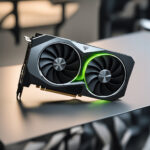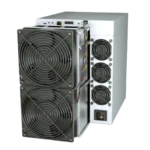The Nvidia RTX 3070 is a popular choice among miners, known for its performance and efficiency in mining cryptocurrencies. To maximize the performance of the RTX 3070, many miners resort to overclocking, a process that involves tuning specific settings to increase hash rates and profitability. This blog post provides a reference for overclock settings using the T-Rex miner and offers tips to ensure stable performance and maintain optimal temperatures.
Why Overclock the RTX 3070 for Mining?
Overclocking can help your RTX 3070 deliver higher mining performance by increasing the hashrate, translating to more profit. However, it’s important to exercise caution, as each GPU behaves differently, and overclocking beyond a GPU’s capacity may cause instability or even hardware damage if not properly managed.
Recommended Overclock Settings for Nvidia RTX 3070
These values are reference points that may need slight adjustment based on individual card variation and mining environment.
- Power Limit: 125W
- Setting a power limit helps control the power consumption of the GPU, reducing heat output. The recommended limit for the RTX 3070 in mining scenarios is around 125W, balancing performance and efficiency.
- Core Clock: +0 MHz
- Keeping the core clock at stock levels or even lowering it slightly is a common approach for mining since mining algorithms rely more on memory performance than on core speed.
- Locked Core Clock: 1400 MHz
- Locking the core clock at 1400 MHz helps stabilize performance and limits unnecessary power usage, which is particularly helpful in maintaining temperature and reducing wear on the GPU.
- Memory Clock: +2200 MHz
- Increasing the memory clock significantly improves mining performance on the RTX 3070. Setting it to +2200 MHz is a common choice among miners, though it’s advised to monitor stability and temperatures closely.
- Fan Speed: 100%
- Running the fan at 100% ensures the GPU remains as cool as possible, especially given the increased power consumption and heat generation from overclocking. Proper cooling is critical, as Nvidia’s 3000 series GPUs tend to run at high memory temperatures.
Mining Software & Client Choice
For Nvidia GPUs, the T-Rex miner is a popular choice due to its stability and compatibility with various mining algorithms, including Ethash and KawPow. It’s known to handle overclocked settings well, ensuring you get a steady hash rate without frequent crashes.
Addressing the Heat Issue: Cooling Tips
The Nvidia 3000 series, including the RTX 3070, is notorious for high memory temperatures, particularly when overclocked. Here are a few cooling tips to help manage the heat effectively:
- Ensure Proper Ventilation: Place your mining rig in a well-ventilated area to allow consistent airflow.
- Use Additional Cooling Solutions: Consider installing aftermarket thermal pads or a dedicated cooling system, such as liquid cooling or external fans.
- Lower Ambient Temperature: Using air conditioning or placing the rig in a cool room can significantly impact temperatures.
Important Note
These overclock settings are merely a reference. Individual GPUs may respond differently to overclocking, and results can vary based on factors like memory type and ambient temperature. Always monitor GPU temperatures and stability, and adjust settings if necessary.
Overclocking can potentially void warranties, so be aware of the risks involved. While overclocking can increase your hashrate and profitability, be mindful of the hardware’s longevity by balancing performance with stability and temperature control.
Mining Profitability: RTX 3070 Performance by Coin
Below is a table displaying the estimated performance and profitability of the Nvidia RTX 3070 across various coins, based on popular mining pools and clients. Keep in mind that these figures fluctuate with changes in electricity costs, network difficulty, and coin prices.
| S.No. | Name | Pool | Algorithm | Hashrate / Power | Est. Daily Income | Costs | Est. Daily Profit |
|---|---|---|---|---|---|---|---|
| 1 | SERO | Super Zero | ProgPowSERO | 23.4 MH/s, 69 W | $0.23 (9.20 SERO) | -$0.17 | $0.07 |
| 2 | HIVEON RVN | PPS Pool | KAWPOW | 28.92 MH/s, 152 W | $0.37 (21.16 RVN) | -$0.36 | $0.00 |
| 3 | 2MINERS BTG | PPLNS Pool | Zhash | 81.62 H/s, 131 W | $0.31 (0.01 BTG) | -$0.31 | -$0.01 |
| 4 | DXPOOL ERG | PPS Pool | Autolykos2 | 173.13 MH/s, 130 W | $0.30 (0.42 ERG) | -$0.31 | -$0.02 |
| 5 | BTCZ | BitcoinZ | Zhash | 81.62 H/s, 131 W | $0.28 (11,448 BTCZ) | -$0.31 | -$0.03 |
| 6 | CTXC | Cortex | Cortex | 0.05 H/s, 99 W | $0.21 (1.04 CTXC) | -$0.24 | -$0.03 |
| 7 | NH Equihash(125,4) | Marketplace | Equihash(125,4) | 47.67 H/s, 109 W | $0.22 (0.000003 BTC) | -$0.26 | -$0.04 |
| 8 | 2MINERS CTXC | PPLNS Pool | Cortex | 0.05 H/s, 99 W | $0.19 (0.98 CTXC) | -$0.24 | -$0.04 |
| 9 | AE | Aeternity | CuckooCycle | 7.72 H/s, 118 W | $0.24 (12.03 AE) | -$0.28 | -$0.04 |
| 10 | BINANCE RVN | PPS Pool | KAWPOW | 28.92 MH/s, 152 W | $0.32 (18.31 RVN) | -$0.36 | -$0.05 |
| 11 | ANTPOOL RVN | PPS Pool | KAWPOW | 28.92 MH/s, 152 W | $0.31 (18.02 RVN) | -$0.36 | -$0.05 |
| 12 | MINERPOOL FLUX | PPLNS Pool | Equihash(125,4) | 47.67 H/s, 109 W | $0.21 (0.40 FLUX) | -$0.26 | -$0.05 |
| 13 | RVN | Ravencoin | KAWPOW | 28.92 MH/s, 152 W | $0.31 (17.92 RVN) | -$0.36 | -$0.05 |
| 14 | RTM | RTM | GhostRider | 1246 H/s, 84 W | $0.15 (169 RTM) | -$0.20 | -$0.05 |
| 15 | FIRO | Firo | FiroPoW | 23.07 MH/s, 119 W | $0.23 (0.19 FIRO) | -$0.29 | -$0.06 |
| 16 | UNM Autolykos2 | Multi-algo Pool | Autolykos2 | 173.13 MH/s, 130 W | $0.26 (0.000003 BTC) | -$0.31 | -$0.06 |
| 17 | 2MINERS RVN | PPLNS Pool | KAWPOW | 28.92 MH/s, 152 W | $0.31 (17.72 RVN) | -$0.36 | -$0.06 |
| 18 | F2POOL RVN | PPS Pool | KAWPOW | 28.92 MH/s, 152 W | $0.31 (17.72 RVN) | -$0.36 | -$0.06 |
| 19 | NH BeamHashIII | Marketplace | BeamHashIII | 35 H/s, 124 W | $0.24 (0.000003 BTC) | -$0.30 | -$0.06 |
| 20 | 2MINERS AE | PPLNS Pool | CuckooCycle | 7.72 H/s, 118 W | $0.22 (11.29 AE) | -$0.28 | -$0.06 |
Conclusion
Optimizing your Nvidia RTX 3070 for mining through overclocking can yield significant results, but it’s crucial to prioritize cooling and stability. With the above settings as a starting point, you can experiment and find the ideal configuration for your mining rig. Remember, every GPU is different, so fine-tuning may be necessary to achieve optimal performance.



